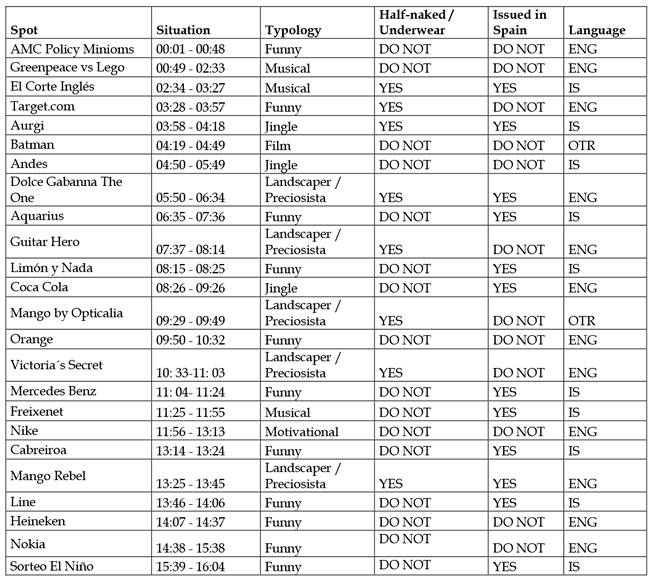
doi.org/10.15178/va.2019.147.1-21
RESEARCH
HALF-NAKED, GENDER AND OTHER FACTORS ON TELEVISION SPOTS. A NEUROSCIENCE APPROACH
SEMIDESNUDO, GÉNERO Y OTROS FACTORES EN PUBLICIDAD TELEVISIVA. UN ACERCAMIENTO DESDE LA NEUROCIENCIA
SEMIDESNUDO, GÊNERO E OUTROS FATORES NA PUBLICIDADE TELEVISIVA. UMA APROXIMAÇÃO DESDE A NEUROCIÊNCIA
Alejandro Tapia-Frade1
Doctor in Advertising from the Complutense University of Madrid (2005). Accredited by ANECA to Profesor Contratado Doctor, has a six-year term of investigation by ACSUCYL. Adjunct professor at Loyola University, Andalusia
Andrés del Toro-Acosta1
1Loyola University. Andalusia, Spain
ABSTRACT
This paper shows the results of an experiment in neuroscience on a group of 20 people of both sexes, whose electrodermal activity was measured simultaneously while they were watching TV spots. Also, we paid special attention to the analysis of gender differences and their attentional and emotional activation patterns. The results show that spots containing half-naked models or models only in underwear are significantly higher in average attendance (in both sexes) with respect to those without this feature. In addition, we also concluded that there were significant differences in relation to the familiarity of the audience with the brand in both sexes too (more attention is paid to known brands) Finally, it was also possible to emphasize that attentional activation occurs to a greater extent at the beginning and end of the spot, although it is more clearly seen in the case of women. Likewise, a common pattern of attentional activation may be suggested when a sound rupture occurs.
KEY WORDS: neuroadvertising, television, attention, emotion, gender
RESUMEN
Este trabajo muestra los resultados de un experimento de neurociencia realizado sobre un grupo de 20 personas de ambos sexos, a las que se midió su actividad electrodérmica de forma simultánea mientras visionaban spots de televisión. Se prestó especial atención al análisis de diferencias de género y sus patrones de activación atencional y emocional. Los resultados ponen de manifiesto que los spots que mostraban modelos semidesnudos o en ropa interior resultan significativamente superiores en atención en ambos sexos respecto de los que no presentan esta característica. También se pudieron concluir diferencias significativas en relación a la familiaridad de los espectadores con la marca en ambos sexos (las marcas conocidas son atendidas en mayor medida). Finalmente, pudo también destacarse que la activación atencional se produce en mayor medida al inicio y finalización del spot, aunque se aprecia más claramente en el caso de las mujeres. De igual modo, se puede sugerir un patrón común de activación atencional cuando se produce una ruptura relevante de registro sonoro.
PALABRAS CLAVE: neuropublicidad, televisión, atención, emoción, género
RESUME
Este trabalho mostra os resultados de um experimento de neurociência realizado sobre um grupo de 20 pessoas de ambos sexos, nas quais foram medidas suas atividades eletro dérmicas de forma simultânea enquanto viam spots de televisão. Prestando atenção especialmente na analises de diferenças de gênero e seus padrões de ativação de atenção e emoção. Os resultados mostram que os spots que mostravam modelos semidesnudos ou com roupa intima resultavam significativamente superior na atenção em ambos sexos. Também foi concluído diferenças significativas em relação a familiaridade dos telespectadores com a marca em ambos sexos (as marcas conhecidas chamam mais a atenção). Finalmente, destacou-se também que a ativação da atenção se produz em maior medida ao início e finalização do spot, apesar que também se aprecia, mas claramente no caso entre as mulheres. De modo igual, pode-se sugerir um padrão comum de ativação da atenção quando se produz a ruptura relevante do registro sonoro.
PALAVRAS CHAVE: neuropublicidade, televisão, atenção, emocional, gênero
Correspondence: Alejandro Tapia-Frade: Loyola University. Andalusia, Spain
ajtapia@uloyola.es
Andrés del Toro-Acosta. Loyola University. Andalusia, Spain.
atoro@uloyola.es
Received: 15/09/2017
Accepted: 11/03/2019
Published: 15/06/2019
How to cite the article: Tapia- Frade, A. and del Toro-Acosta, A. (2019). Half-naked, gender and other factors on television spots. A neuroscience approach. [Semidesnudo, género y otros factores en publicidad televisiva. Un acercamiento desde la neurociencia]. Vivat Academia. Revista de Comunicación, 147, 1-21. http://doi.org/10.15178/va.2019.147.1-21. Recovered from http://www.vivatacademia.net/index.php/vivat/article/view/1101
1. INTRODUCTION
The appeal to sensuality, to suggested beauty, is undoubtedly one of the most used in advertising. So much so that people have come to talk about the concept of sensual marketing (Moreno, 2004).
In this context, it is important to note the abundance of literature about advertising and the perception of gender stereotypes handled by it. Thus, Moreno and Martínez (2012) point out that the stereotypical production of television spots gives men values such as strength, arrogance, bravery, risk, recklessness or dominance, while for women it reserves meanings associated with beauty, sweetness, tenderness, affection or reflection.
Previously, Soloaga (2007) in a study on luxury brand advertising in Spain noted that advertising praises values associated with a woman understood as an object of desire that pursues beauty and youth as essential values.
Without wishing to expand on the issue, references to the studies of David and Johnson (1994), Kang (1997), David, Morrison, Johnson and Ross (2002), Lindner (2004) and Dittman and Howard (2004) are a must, in a theoretical line similar to that described above.
However, more avant-garde advertising representations tend to a more egalitarian representation of women, in which women assume roles traditionally forbidden to their condition, associating them with power, capacity, strength, personal fulfillment and even aggressiveness. (Garrido Lora, 2007, p. 67).
It should also be mentioned, in the opinion of the same author, that the representation of masculinity has undergone an important transformation in advertising messages, which abandons the aforementioned solid profile in favor of a more plural image, in which sensitivity, aesthetic concern or occupation in housework or work proper to paternity, once the stereotypical patrimony of women (Garrido Lora, 2007, p. 67).
However, it is also necessary to ask whether these stereotypical roles promoted by advertising in fact arouse the attention of viewers, the recipients at the end of such advertising.
Psychobiological research on the recipients could be a valid way to such a study. In fact, it has been mentioned that, if you analyze a person who visualizes an advertisement, you could control three fundamental variables of the process, which are attention, emotion and memory, which could optimize it so that it will cause greater impact (Torreblanca et al., 2012).
In addition, literature in relation to the study of the effects of advertising through neuroscientific techniques is increasingly abundant.
Thus, in a paper on brand familiarity, two experiments were conducted to analyze neurophysiological activation, response latency to such activation, and the choice of new brands and familiar brands. The results show that (1) the choice of new brands (as compared to the choice of known brands) is preceded by an increase in the activation of the prefrontal cortex, measured by means of functional magnetic resonance (fMRI); (2) the choice of new brands is associated with higher response latency than the known brands; and (3) the positive mood improves response latency of the choice of new brands as compared to known brands (Reimann, 2012).
Another study, in this case one carried out on spots by electroencephalography and galvanic response to 28 people, revealed significant differences in attention and emotion between genders according to the categories of visualized products (Vecchiato et al., 2014b). Another, based on the Coca Cola brand, highlighted the importance of music as a persuasive element in audiovisual marketing (Sanchez-Porras, 2013).
Another piece of research carried out on outdoor advertising highlighted creativity and attention as fundamental conductors of success in advertising, specifically in relation to the improvement of brand recall. (Wilson, 2015, p. 232).
Finally, another paper on TV spots that used biometric indicators and eyetracker demonstrated the value of television as a tool to attract and maintain an emotional response. In addition, said piece of research showed that emotional engagement was increased when the participants in the study combined visualization of similar content on TV and on the Internet simultaneously (Steele et al., 2013, p. 417).
In this context, this article shows the results of a neuropublicity experiment in which the electrodermal activity of 20 people of both sexes was simultaneously analyzed while they were viewing spots in which semi-nude models or models only in underwear mixed with others that did not have this quality.
In addition, in this analysis other factors that could be relevant in the processes of attentional and emotional activation of said subjects were tested. In particular, different commercial formats were tested, and the role played by brand knowledge and the locution language of the spot in the activation of said processes was explored.
2. OBJECTIVES
The knowledge objectives proposed for this paper are:
3. METHODOLOGY
The sample, chosen through the convenience sampling method, consists of 20 people aged 20 to 30 years of both sexes (in a similar proportion). Therefore, it is a sample whose results should be considered to be exploratory.
The broadcast and subsequently analyzed spots are shown in the following table.
Table 1. Spots issued.

Source: own elaboration.
Así, se diferenció si en el spot aparecían modelos semidesnudos o en ropa interior.
On the other hand, the spots were classified according to a typology designed ad hoc. Specifically, the possibilities that were listed for both types were jingle, musical, comic, landscape/precious, Spices of life/local-custom-related, motivational and cinematographic characters.
It also highlighted the brand responsible for the spot and whether it was broadcast in Spain, which can be related to the a priori familiarity developed with the brand and the spot.
Finally, the language of the locution of the spot (Spanish, English and another or without any locution) is also indicated, since it could have an impact on the understanding of the spot, and this one on the attention deployed to understand it and the emotional intensity developed.
A pass of 20 people was held on April 22, 2015 in the room of degrees of Miguel de Cervantes European University, in Valladolid. At the entrance to the premises, a bracelet was placed on the participants, which sent the information of each person to a central processing unit, in charge of the necessary calculations and their storage.
The measuring instrument analyzes the electrodermal activity in three types of signals:
This technology, named Sociograph, patent number 9902767, has been used with favorable results in previous cases such as Martínez Herrador, J. L. et al. (2008, 2012) and Aiger, M. et al. (2013), among others.
4. RESULTS
Prior to analysis, it should be noted that the test was performed in response to a time series model with strong autocorrelation, representing the significant impact of the above values of attention (EDL) on the later ones. Emotion, due to its sudden nature, does not have this dependence.
4.1. Attention
The average level of attention for the whole sample is 176.0634 KΩ (244,7952 in the case of men and 152,5265 in the case of women), with a standard deviation of 20,4036 (being of 19,5325 in the case of men and 20,04831 in the case of women).
The kurtosis (-1, 108) and asymmetry (0.110) coefficient of Fisher for the whole sample suggests a platicuric distribution with slight asymmetry to the right or positive. In the case of men, we can also speak of a platicuric distribution (Coef, Curtosis: -0,822), less pronounced than in the case of women (-1,122), and more asymmetric to the right (Coef Asymmetry Men: 0,337) the latter (0.085), which have quasi-symmetry.
It should also be noted, before presenting the results in detail, that the level of attention is measured in terms of resistance, so that the greater the value of resistance, the lower the level of attention, and vice versa. In order to simplify the reading of the subsequent graph, the values have been inverted, so that the closer to zero the value, the higher the level of attention.
Source: own elaboration.
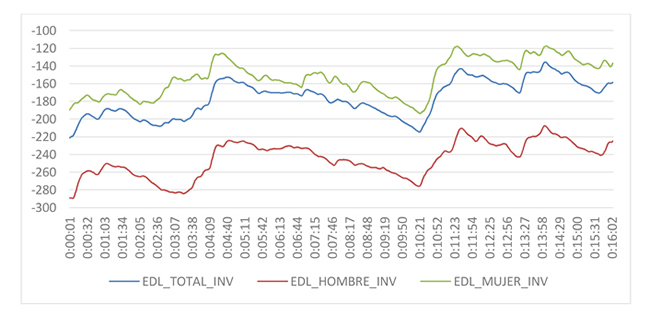
Graph 1. EDL (electrodermal level) of the broadcast according to sex. (-ΣKΩ)
Thus, a growing global structure with visible alterations, which will be the subject of further analysis, should be noted.
Although it should be noted that, when using the LDS, a model of time series with strong autocorrelation, the analysis of the attention curve (EDL) should be based on the estimation of the change rates of said variable, which can be seen in Graph 2. In this graph, increases in the level of EDL imply an increase in attention, and its decrease decreases. Therefore, the most notorious characteristic of the series is the growth or decrease of the curve and its intensity at the different moments of the broadcast.
Source: own elaboration.
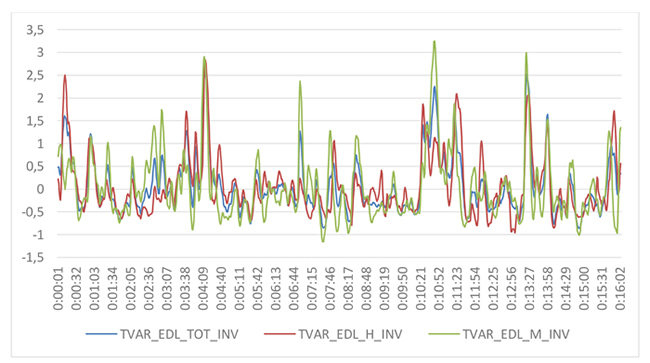
Graph 2. Absolute Variation on inverted EDL of the broadcast by sex. (-KΩ).
Undoubtedly, points can be seen in which said rate of change undergoes remarkable alterations, these being the moments in which the attention is increased by a certain stimulus. The moments of greatest alteration are the following:
1) AMC Sprint. Women (00: 01-00: 09) - EDL Variation Rate (ΔKΩ): 6.986 -. It is the beginning of the spot. In visual, you can see some minioms sitting in the cinema, and a purple miniom appears, which eats a chair. In sound, an English voice-over signals “this is Dave, he really enjoys going to the movies, and he is always considered with...” The purple miniom screams.
2) AMC Sprint. Men (00: 09-00: 25) - Variation Rate EDL (ΔKΩ): 27,785 -. In visual, the purple miniom eats an arm of an armchair. Dave takes out the cell phone to turn it off, but the purple miniom eats it. Afterwards, the cell phone rings, Dave tightens the belly of the purple miniom and the phone turns off.
3) Greenpeace. Men and women (00: 53: 01: 04) - Variation Rate EDL (ΔKΩ): H (11,126) M (7,765) -. Initial moments of the spot. In visual, you can see long shots of Lego figures (two bears, some wolves, an Eskimo fishing and a group of ice hockey players, a gull.) In sound, an instrumental song begins, there is no voice.
4) El Corte Inglés. Women (02:40 - 02:51) - Variation Rate EDL (ΔKΩ): 12,227 -.Initial moments of the spot. In visual, a woman leaves a room. Long (more abundant) and medium shots of a woman dressed in different ways are appreciated. In sound, a door slam, and the beginning of a song.
5) Target.com. Men (03:38 - 03:48) - Variation Rate EDL (ΔKΩ): 12,357 -. In visual, Darth Vader is seen sitting on a chair. A door sounds and Heidi Klum appears, who sits next to him. Dath Vader looks at her. In sound, the only thing that stands out is that Dath Vader’s breathing is accelerated by the presence of Heidi Klum.
6) Aurgi. Men and women (04:07 - 04:22) - Variation Rate EDL (ΔKΩ): H (26,690) M (26,859) -. In visual, on a green background, Rebecca is seen, dressed sensually, singing. The increment section reaches the end of the spot. In sound, a very shrill song sounds.
7) Aquarius. Women (06:53 - 07:01) - Variation Rate EDL (ΔKΩ): 14,093 -. In visual, you can see long shots of a woman, a vegetable greengrocery store, an elderly man sleeping while sitting, a wet woman, a man playing ping pong and some children running. In sound, a voice-over tells the life of a town.
8) Orange. Men (10:23 - 10:32) - Variation Rate EDL (ΔKΩ): 13,689 -. It is the conclusion of the spot. In visual, the phrase “life is full of choices. Have you made the right one?” can be seen on a black background. The spot ends with the logo of Orange. In sound, an instrumental song is noticed. There is no voice.
9) Victoria Secret. Men and Women (10.33 - 11.03) - Variation Rate EDL (ΔKΩ): H (20,811) M (46,261) -. Increased attention throughout the spot. In visual, up to 8 women can be seen in underwear alternating short and long shots. In sound, a sensual song is played.
10) Mercedes Benz. Men and women (11:08 - 11:24) - Variation Rate EDL (ΔKΩ): H (11,189) M (17,781) -. In visual, a boy and a girl are seen sitting on a sofa and talking. In sound, their conversation is the protagonist. In the case of women, they are the initial moments of the spot. In the case of men, the increase in attention occurs towards the middle of it.
11) Freixenet. Men (11:25 - 11:34) - Variation Rate EDL (ΔKΩ): 14,914 -. It is the beginning of the spot. In visual, a group of women dressed in gold dance to the sound of a song. In sound, the song, by Bisbal, has an intense rhythm.
12) Cabreiroa. Men and women (13:20 - 13:24) - Variation Rate EDL (ΔKΩ): H (6,877) M (12,016) -. It is the closing of the spot. In visual, you can see the front of a bicycle with a bottle of the brand. In sound, a female voice-over says “Cabreiroa, balanced water for people who do not stop.”
13) Handle. Men and women (13:25 - 13:34) - Variation Rate EDL (ΔKΩ): H (14,719) M (8,908) -.Start of the spot. In visual, short planes of the face of a black and white model can be seen. Only in the case of men, the model takes off his shirt. In sound, the spot starts with a very strident song
14) Line. Men and women (13:54 - 14:03) - Variation Rate EDL (ΔKΩ): H (9,540) M (9,457) -. In visual, you can see a man with a phone and a panic face. Long shots of the man lying on the ground alternate with short shots of him and another man. In sound, a part starts with a battery.
15) Sorteo “El Niño”. Men (15:47 - 15:57) - Variation Rate EDL (ΔKΩ): 13,414 -. In visual, you can see an elderly couple sitting on a sofa. In sound, the old man tells how heavy it has been for them to put up with the whole family during Christmas.
After analyzing the EDL increment sections, we can point out that they are more frequent in the initial and final sections of the spots in the case of women (6 out of 9 occasions), but not in the case of men (5 out of 11 cases). In sound terms, a common pattern of initiation of the sections with a change of sound record relevant to the previous moments seems to be noticed, which can be seen with greater clarity in the case of women (this circumstance occurs 7 times compared to 2). that do not occur, although in one a song persists with a very high rhythm) than in men (it occurs in 8 occasions compared to 4 in which it does not occur, although in 2 these occur in the context of a very-high-rhythm song).
On the other hand, it should be noted that 5 of the 8 spots that show semi-nude models or models in underwear show significant attentional alterations, as compared to 9 of the 16 that do not have this characteristic.
Regardless of the moments when the attention is suddenly increased, it is worth noting which spots have a general balance of positive EDL (which is why they attract attention) and which ones a negative balance (which is why they are spots that distract or disperse attention).
The results can be seen in the following table.
Table 2. Balance in EDL variation rate (ΔKΩ).
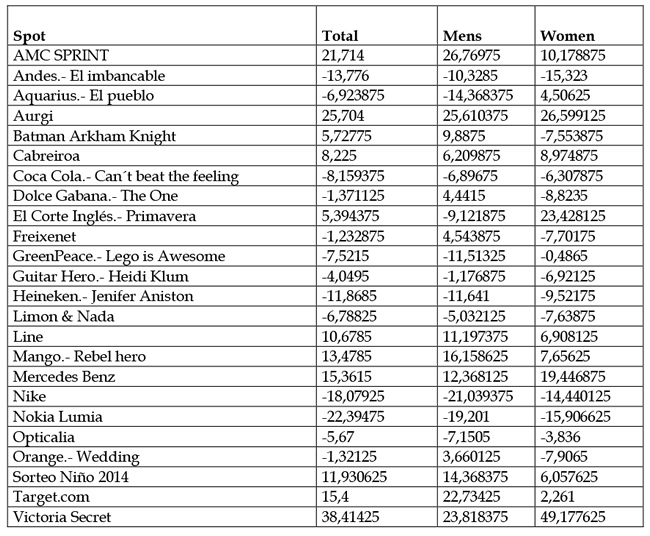
Source: own elaboration.
Thus, in the case of women, the performance of the Victoria Secret spot excels, and later those of Aurgi, El Corte Inglés and Mercedes Benz. It should be noted that 3 of the 4 have naked models or models in underwear. On the opposite side, the spots that got the worst response were those of Nokia Lumia, Cerveza Andes and Nike, none of them being sensual.
In the case of men, on the positive side, the scores of AMC Sprint, Aurgi, Victoria Secret and Target.com stand out-in this case, 3 of the 4 have half-naked models. Similarly, those who got the worst response were Nike, Aquarius and Andes - it is also noteworthy that, as in the case of women, none contains such models.
The typology of the spots that stand out both positively and negatively is varied in both sexes, which does not allow us to suggest an attentional trend towards any specific typology.
In any case, comparison tests (ANOVA of a factor) were carried out to verify this trend. The results obtained indicate the non-existence of a typology statistically superior to the rest for the three studied groups (men, women and all cases).
On the contrary, it was possible to contrast (using the same method indicated above) that the average change rate in attention developed by the spots in Spanish was significantly higher than those broadcast in English or without locution in the case of women and in the group of all cases (p = 0.000 and 0.001 respectively).
In the case of men (p = 0.009), no significant differences were found in the spots broadcast in Spanish and English, but both in relation to the spots without locution.
Regarding the spots broadcast and not broadcast in Spain, it should be noted that significant mean EDL differences (by means of a T test) could be contrasted in favor of the spots broadcast in Spain in all the studied cases (p = 0.000, 0.011 and 0.000 for all cases, men and women respectively).
In the case of spots with semi-nude actors or actors in underwear, the comparison tests carried out indicate that the average change rate in attention (or, what is the same, the average increases in attention paid to the spot) is significantly higher in the spots with half-naked models or models in underwear in all the analyzed cases (men, women and all, T-test of difference of means with p = 0.000, 0.006 and 0.000).
4.2. Emotion
The average level of EDR presented by the series is 0.1803163 KΩ in the case of men and 0.2040547 in the case of women. The standard deviations are respectively 0.23505 for men and 0.29650 for women, which suggests greater dispersion in the case of women. The pointing coefficients for men (17,465) and women (23,283) suggest the presence of leptocurtic form in both distributions (more pronounced in the case of women) and the asymmetry coefficients (3,453 and 4,008 respectively) indicate an asymmetric distribution to the right.
So, we must conclude that there is similar intensity in terms of emotion (EDR) throughout the broadcast in men and women, which does not imply that the stimuli that initiate the process of emotional stimulation are the same, as we will see later.
Therefore, the analysis of the level of EDR in the subsequent time series shows sudden changes in the resistivity of the skin that are related to reactions to specific stimuli, different in men and women, as can be seen in Figure 3, which is shown below.
Source: own elaboration.
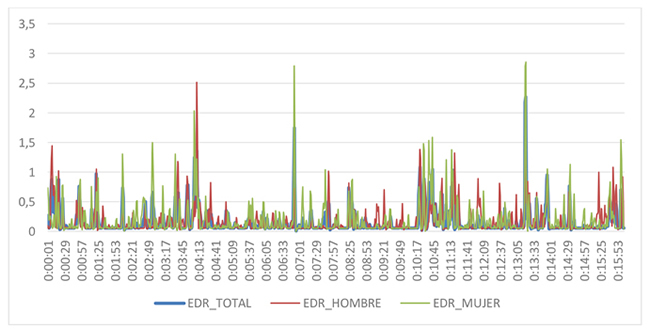
Graph 3. EDR (electrodermal response) of the broadcast according to sex (KΩ).
Thus, sudden changes of EDR record for men can be seen in the moments 4: 09 to 4:11 (very intense), 00:06 a 00:09, 10:22 to 10:24 and 11:21 to 11: 22 (of less intensity).
In the case of women, it is worth mentioning very relevant changes in the moments 4:06 to 4:07, 6:52 to 6:54 and 13:19 to 13:21. In addition, although of minor importance, it is also necessary to point out moments of change in 2:55 to 2:57, 10:29 to 10:30, 10:37 to 10:44 and 15:59 to 16:01.
The sound and visual stimuli that initiate these changes are described in the following table.
Table 3. Changes in EDR (KΩ) and description of the stimulus.
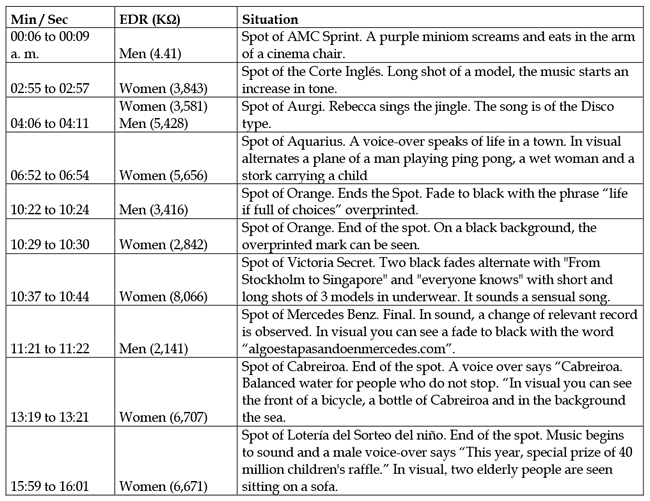
Source: own elaboration.
In effect, a common pattern of sound change can be suggested in the stimuli described in the table (it occurs in 6 of the 9 cases). They also usually occur in visual changes, such as the initial or final moments of the spots.
An objective relationship between EDL change rates and EDR peaks could be contrasted for all the studied cases (total, men and women), in all cases, P = 0.000, and Pearson Corns, 0.380, 0.305 and 0.285. respectively). That is to say, it can be affirmed that, when an emotional increase occurs, there also tends to be an attentional increase, and vice versa.
In addition, 9 of the 10 emotional peaks occur in increments of attention. Therefore, it should be noted that there is a pattern of joint change between attention and emotion.
Another issue is the average emotion generated by each spot, which is shown in Table 4.
Table 4. Average EDR (KΩ) per spot and sex.
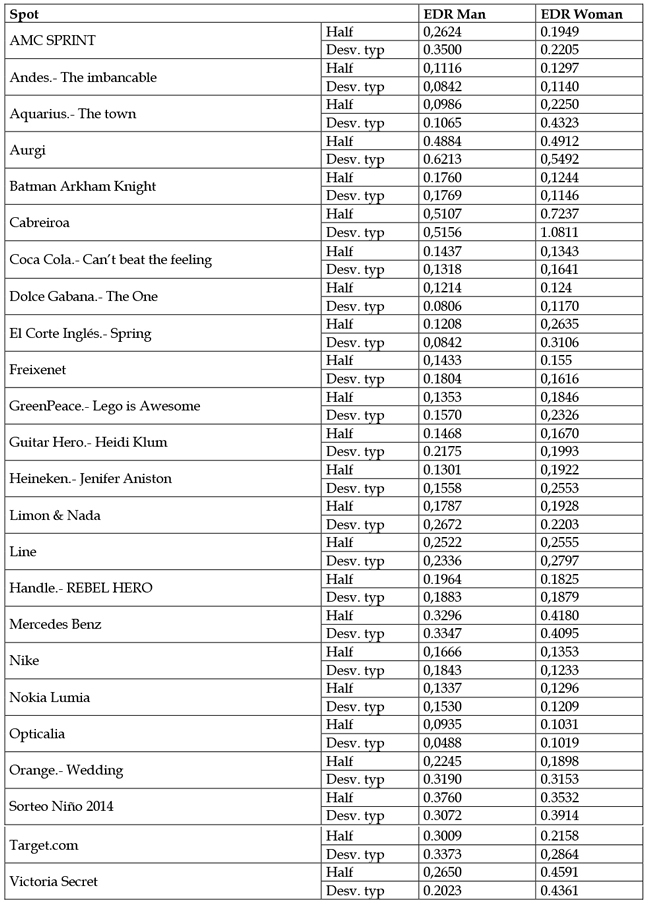
Source: own elaboration.
Thus, in the case of men, the performance of Aurgi, Cabreiroa, Mercedes Benz and National Lottery El Niño stand out. In the case of women, the Aurgi, Cabreiroa, Mercedes Benz and Victoria Secret spots stand out. On the opposite side, the spots of Opticalia, Aquarius, Andes, Dolce Gavana and El Corte Inglés stand out negatively for men. Outstanding is the fact that three of the five cases refer to fashion products. In the case of women, the spots of Opticalia, Andes, Batman Arkham Knight, Dolce Gavana and Nokia Lumia stand out negatively.
The typology of the remarkable spots, both positively and negatively, is varied in both sexes, which does not allow us to suggest an emotional tendency towards any specific typology.
However, comparison tests (ANOVA of one factor) were carried out to corroborate this trend. The results obtained indicate the non-existence of a typology statistically superior to the rest for the three studied groups (men, women and all cases).
Neither can anything be affirmed in relation to the presence of semi-nude models or models in underwear (in fact, the contrast tests carried out do not establish significant differences in the average amount of EDR with respect to this quality of the spots).
On the contrary, if it was possible to contrast (also using ANOVAS of a factor) that the average amount of emotion developed by the spots in Spanish was significantly higher than those broadcast in English or without locution in the case of women and in the group of all the cases (p = 0.000). This difference was not significant in the case of men (p = 0.060).
Finally, as in the previous case, significant mean differences in EDR (by a t - test) could be contrasted in favor of spots broadcast in Spain in cases of women and all cases (p = 0.003 and 0.030 respectively). This difference, as in the previous case, was not significant in the case of men (p = 0.338).
5. DISCUSSION
Attentional activation occurs to a greater extent at the beginning and end of the spot, although it is more clearly seen in the case of women. Likewise, it may suggest a common pattern of attentional activation when a relevant sound record rupture occurs.
The typology of the spots that stand out in attention, both positively and negatively, is varied in both sexes, which does not allow us to suggest an attentional trend towards any specific typology. That is, there is no typology that is significantly superior to the rest, neither in men nor in women.
However, in all cases (men, women and all), it was possible to relate higher average increases in attention paid to spots with semi-nude models or models in underwear.
Likewise, it could also be contrasted that the average exchange rate in attention developed by the spots in Spanish was significantly higher than those broadcast in English or without locution in the case of women and in the group of all cases. In the case of men, no significant differences were found in the spot broadcast in Spanish and English, but both in terms of the spots without locution.
Regarding the spots broadcast and not broadcast in Spain, it should be noted that significant average EDL differences could be contrasted in favor of the spots broadcast in Spain in all the studied cases. Therefore, we can rule out that familiarity is a factor against attention (contrary to fact).
In relation to patterns of emotional activation, it should be noted first that an objective relationship between EDL change rates and EDR peaks could be contrasted for all the studied cases. That is to say, it can be affirmed that the activation of emotional response tends to occur in a context of attentional activation.
As with the EDL, no significant differences were found in any type of spot with respect to the others in any of the studied groups (men and women), but it was possible to contrast significant differences in the language of the spot and if it was broadcast in Spain, although only in the case of women. In other words, familiarity with the spot and that it is recorded in Spanish supposes for women two favorable factors for the generation of emotional content.
The most important limitation of this piece of research is to consider the limited size of the studied sample, 20 people. However, recent studies indicate that the sample chosen for a study of these characteristics is correct and the results reliable (Karmarkar, 2015, Orzan, 2015, Vecchiato, 2014, Martínez Herrador, 2012, Reimann, 2012).
Future lines of research could delve into the emotional content generated by the different types of spots, or consider the fact of multitasking in the processes and patterns of attentional and emotional activation while watching television and other media –cell phones, tablets, etc.
REFERENCES
1. Aiger, M.; Palacín, M., y Cornejo, J. M. (2013) La señal electrodérmica mediante Sociograph: metodología para medir la actividad grupal. Revista Internacional de Psicología Social: International Journal of Social Psichology, 28(3), 333-347.
2. David, P., y Johnson, M. (1998). The Role of Self in Third-Person Effects about Body Image. Journal of Communication, 48(4), 37-58.
3. David, P.; Morrison, G.; Johnson M., y Ross, F. (2002). Body Image, Race, and Fashion Models. Social Distance and Social Identification in Third-Person Effects. Communication Research. 29(3), 270-294.
4. Dittmar, H., y Howard, S. (2004). Professional hazards? The impact of models’ bodysize on advertising effectiveness and women’s body-focused anxiety in professions that do and do not emphasize the cultural ideal of thinness. British Journal of Psychology, 43, 477-497.
5. Garrido Lora, F. (2007). Estereotipos de género en Publicidad. La creatividad en la encrucijada sociológica. Creatividad y Sociedad, 11, 53-71.
6. Karmarkar, U.; Yoon, C., y Plassmann, H. (2015). Marketers should pay attention to fMRI. Harvard Business Review. Recuperado de https://hbr.org/2015/11/marketers-should-pay-attention-to-fmri
7. Kang, M. (1997). The portrayal of women’s images in magazine advertisements: Goffman’s gender analysis revisited. Sex Roles. A Journal of Research. Gale Group.
8. Lindner, K. (2004). Images of women in general interest and fashion magazine advertisements from 1955 to 2002. Sex Roles. A Journal of Research, 51, pp. 409-421.
9. Martínez Herrador, J. L.; Garrido Martín, E.; Valdunquillo Carlón, M. I., y Macaya Sánchez, J. (2008). Análisis de la atención y la emoción en el discurso político a partir de un nuevo sistema de registro psicofisiológico y su aplicación a las ciencias políticas. DPSA. Documentos de trabajo del Departamento de Psicología Social y Antropología, 2. Recuperado de http://hdl.handle.net/10366/22533
10. Martínez Herrador, J. L.; Monge Benito, S., y Valdunquillo Carlón, M. I. (2012). Medición de las respuestas psicofisiológicas grupales para apoyar el análisis de discursos políticos. Tripodos, 29, 53-72.
11. Moreno, J. (2004). Iconos femeninos. Jordi González lanza el concepto de “marketing sensual”, con el que sale en defensa de la publicidad ante los ataques que ésta recibe por determinados usos de la imagen de la mujer. Anuncios, 1079, 30.
12. Moreno, R. & Martínez, M. M. (2012). Representación del hombre y de la mujer en la publicidad: análisis de los valores percibidos por el alumnado en función del género del protagonista del anuncio. Actas del I Congreso Internacional de Comunicación y Género. Sevilla, 5, 6 y 7 de Marzo de 2012. Sevilla: Facultad de Comunicación. Universidad de Sevilla.
13. Orzan, G.; Zara, I., y Purcarea, V. L. (2015). Neuromarketing techniques in pharmaceutical drugs advertising. A discussion and agenda for future research. Journal of medicine and life, 5(4), 428-432.
14. Reimann, M.; Castano, R.; Zaichkowsky, J., y Bechara, A. (2012) Novel versus familiar brands: an analysis of neurophysiology, response latency and choice. Marketing letters, 23(3), 745-759. doi: 10.1007/s11002-012-9176-3
15. Sanchez-Porras, M. J. (2013). Music persuasión in audio-visual marketing. The example of Coca Cola. Historia y Comunicación Social, 18, 349-357. doi: 10.5209/rev_HICS.2013.v18.44333
16. Soloaga, P. (2007). Valores y estereotipos femeninos en la publicidad de moda de lujo en España. Anàlisi, 35, 27-45.
17. Steele, A.; Jacobs, D.; Siefert, C.; Rule, R.; Levine, B., y Marci, C. (2013). Leveraging Synergy and Emotion In a Multi-Platform World A Neuroscience-Informed Model of Engagement. Journal of Advertising Research, 53(4), 417-430. doi: 10.2501/JAR-53-4-417-430
18. Torreblanca, F.; Juarez, D.; Sempere, F., y Mengual, A. (2012). Neuromarketing: la emocionalidad y la creatividad orientadas al comportamiento del consumidor. 3Ciencias, revista de investigación. http://hdl.handle.net/10251/34357.
19. Vecchiato, G. et al. (2014). How to measure cerebral correlates of emotions in Marketing relevant tasks. Cognitive Computation, 6(4), 856-871. doi: 10.1007/s12559-014-9304-x.
20. Wilson, R.; Baack, D., y Till, B. (2015). Creativity, attention and the memory for brands: an outdoor advertising field study. International Journal of Advertising, 34(2), 232-261. doi: 10.1080/02650487.2014.996117
AUTHORS
Alejandro Tapia-Frade: Degree in Advertising (1999) and a PhD in Marketing (2005), both from the Complutense University of Madrid. Accredited to the Characters of Professor Contratado Doctor and Professor of Private University (ANECA and ACSUCYL), also counts on a section / sexenio of investigation (ACSUCYL), fruit of the publication of approximately fifty chapters of book and articles in indexed magazines. University professor with eight years of experience, before in the Social Sciences department of the European University Miguel de Cervantes, in Valladolid, and now in the Department of Communication and Education of the Loyola University of Andalusia. In addition, teacher exchanges were held at the universities of Leiría and Guarda (Portugal), Konstanz (Germany) and Arnhem (Holland). Previously to his university stage, during seven years he was a consultant of corporate applications in Internet environments in several technological companies (Software AG, Everis).
ajtapia@uloyola.es
Orcid ID: http://orcid.org/0000-0003-1071-4536
Google Scholar: https://scholar.google.es/citations?user=CRPQeigAAAAJ&hl=es
ResearchGate: https://www.researchgate.net/profile/Alejandro_Tapia_Frade
Andrés del Toro-Acosta: Graduate and Doctor in Advertising (2015). He has worked in the world’s leading Public Relations agencies as Ogilvy in Madrid and Weber Shandwick in Madrid and London, holding different positions until the Accounts Department. From these positions, I have worked for clients from various sectors such as the European Commission and Parliament, Turespaña, Ford, Carrefour, Kellogg’s, Coca-Cola, Danone Institute, Ikea, Canon, Siemens, ANEABE or Cerámica de España, among many others. Associate professor and researcher specializing in social media strategy, personal branding, digital content management, corporate communication, strategic planning and communication trends at Loyola University, Andalusia. He has also made research stays at the University of Rotterdam (Holland).
atoro@uloyola.es